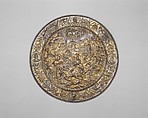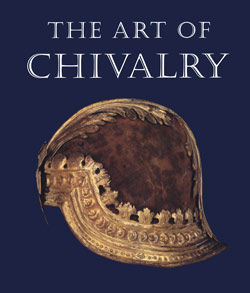Parade Shield Depicting the Conversion of Saint Paul
The circular shield of blue-black steel is slightly convex in shape and is embossed in relief, chiseled, punched, and richly damascened in gold and silver. The outer edge is rolled over and obliquely striped in gold and silver. A wide band along the outer edge is embossed with four round medallions which are framed by damascened strapwork and contain portrait busts of four Roman emperors. The medallions are connected to one another by ribbons from which are suspended trophies of antique and Renaissance arms, bunches of fruit and flowers, and putti with fluttering striped drapery. The large circular field at the center, framed by a laurel wreath of alternating gold and silver leaves, contains a representation of the Conversion of Saint Paul. The figures are dressed in Roman armor, their flesh silvered, and the details of the costumes and landscape damascened in different patterns. A series of holes around the edge of the shield formerly held rivets to secure the lining, with its arm pad and straps for the forearm and hand, now missing.
The scene depicted on this shield forcuses on the most dramatic moment in the life of Saint Paul, his conversion on the road to Damascus: "And as he journeyed, he came near Damascus, and suddenly there shined a light from heaven and he fell to the earth, and heard a voice saying unto him, Saul, Saul, why persecutest thou me?" (Acts of the Apostles, 9:3–4). Saul (as Saint Paul was known prior to his conversion) is shown thrown to the ground, his horse collapsed under him, with his hands shading his eyes from the blinding apparition. Two of his troopers attempt to assist him, whereas the rest of his band stare in amazement or flee in terror. The deep landscape that opens into the background includes a city of domed buildings, tall pyramids, and statues, and the left three tiny figures can be seen: Saul, blinded by his vision, is led by two companions to Damascus, where his eyesight will be restored and his newfound Christian faith confirmed.
Circular or oval iron shields embossed in relief with scenes taken from ancient, Biblical, or even contemporary history, or from classical mythology, were a specialty of Milanese armorers and goldsmiths in the second half of the sixteenth century. These shields were often accompanied by open helmets of burgonet or cabasset type decorated to match which, when worn with a fabric costume, mail, or even plate armor modeled upon Roman prototypes, constituted a parade armor in the heroic style. Embossed iron, richly colored and damascened in gold and silver, provided an excellent medium for representing complex, figural scenes which were usually based on engravings issued by Italin and French printmakers. The graphic sources for the decoration of this shield can be identified: the putti and bunches of fruit and flowers suspended from ribbons that decorate the rim appear to be based upon the ornamental border of a print by French engraver Jean Mignon at Fontainebleau, and the scene of the Conversion of Saint Paul derives from a print of that subject by the Parisian engraver Etienne Delaune. Delaune's print is undated, but it must have been issued before 1567 when an exact copy of it was published by Mario Cataro in Rome (acc. no. 59.595.16). In light of the fact that there are no major differences between the Delaune print and the copy by Cataro, there is no way of ascertaining which print served as the model for the armorer. If the print by Cataro was used, the shield must date after 1567.
The Conversion of Saint Paul seems to have been a popular Christian theme for the decoration of these shields (most of which favored ancient history in their subject matter) and is found on two shields in the Musée de l'Armée, Paris (inv. nos. I.65 and I.79), four shields in the Armeria Reale, Turin (inv. nos. F.17, F.19, F.20, and F.21), and on a cabasset in the Wallace Collection, London (inv. no. A. 133). The scene on the cabasset also appears to be based upon the same print by Delaune or Cataro.
Due to rights restrictions, this image cannot be enlarged, viewed at full screen, or downloaded.
This artwork is meant to be viewed from right to left. Scroll left to view more.


s2.jpg)

